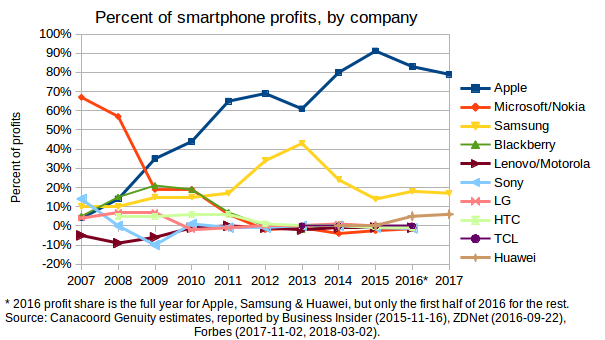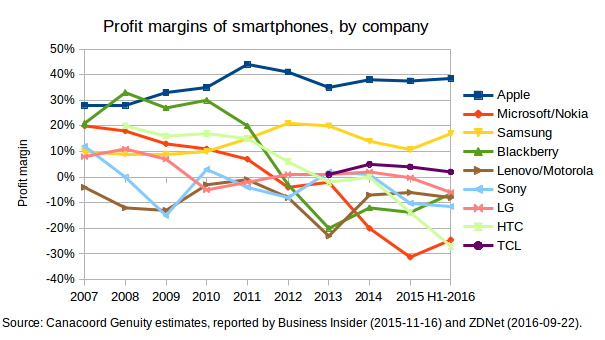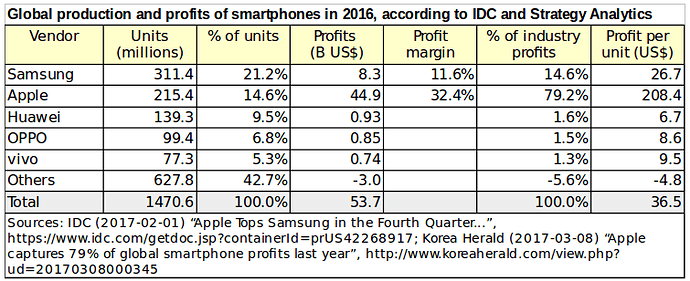If we can believe the industry analysts at Canaccord Genuity and Strategy Analytics, Apple has about a 40% profit margin on its phones and it used to take about 80% of the total profits in smartphone industry. Now that demand for iPhones is falling, it probably has a smaller share of total profits. Samsung used to have about a 15% profit margin on its phones, but Samsung was losing so much market share to Oppo,Vivo, Realme, Xiaomi and Huawei at the mid-range that it slashed prices with its 2019 A-series and M-series, so it probably isn’t making much profit any more except on its high-end S-series. Huawei took 6% of the total profits in the industry in 2017. BBK Electronics (owner of Oppo, Vivo, Realmi & OnePlus) and Xiaomi basically just break even and all the rest of the phone makers (LG, HTC, Sony, Motorola, Google, ZTE, TCL) lose money, but they keep producing phones for strategic reasons.
In 2016, the phone makers, who weren’t in the top five producers, lost an average of $4.8 per smartphone. I suspect that it is the same situation today for most phone makers. Sony makes money on image sensors, and it thinks that it needs to be in the phone business because it is important for the future of the company to be in the most important tech market in the world. LG makes money on its screens, so its phones are a way to show off its screens, plus it is important for its image as a tech company. Google makes huge profits on Android through targeted advertising, so it can afford to lose money to demonstrate the tech and show off its cutting edge ideas and stock Android. HTC is a train wreck, and the only thing keeping it afloat are virtual reality goggles and Google giving it cash by buying its employees. Motorola is doing better now, but it gave up competing for market share in 2015 and ceded the market to BBK Electronics, Huawei and Xiaomi. Xiaomi makes money on its products in its stores and online advertising, so the phones are the vehicle to profits through other means. BBK Electronics seems to want to grow market share at any cost, which is why it undercuts everyone. Its Realmi is now undercutting Xiaomi, so it is hard to see how it can make any profits, but as the second largest smartphone maker in the world, it must have amazing economies of scale. Huawei makes some profits, but it gives cellular network providers discounts on its telecom equipment if they offer its phones to their customers. ZTE lost massive amounts of money from the US embargo, but it managed to essentially bribe Trump to get back into the US market. TCL (which sells the Alcatel and Blackberry brands) has been doing horribly in recent years. Transsion Holdings makes money in Africa, but it is losing money trying to expand into India and the Asian markets. I haven’t checked what is happening in HDM Global (Nokia brand).
Here are some charts that I made about profits in the smartphone industry:


Looking at these numbers is why I worry about Purism. As I said at the beginning of this thread, I hope that Purism makes good profits on the Librem 5 USA, because it needs them. It is very, very hard to make a profit on smartphones, but at least Purism has the right strategy of following Apple’s model of controlling both the hardware and software and catering to niche markets that no other company serves, so it can charge more, and isn’t stuck in a cut-throat race to the bottom like all the companies making commoditized Android devices.


 People have different ways of sounding on here despite their true intentions being fair and ethical.
People have different ways of sounding on here despite their true intentions being fair and ethical.

